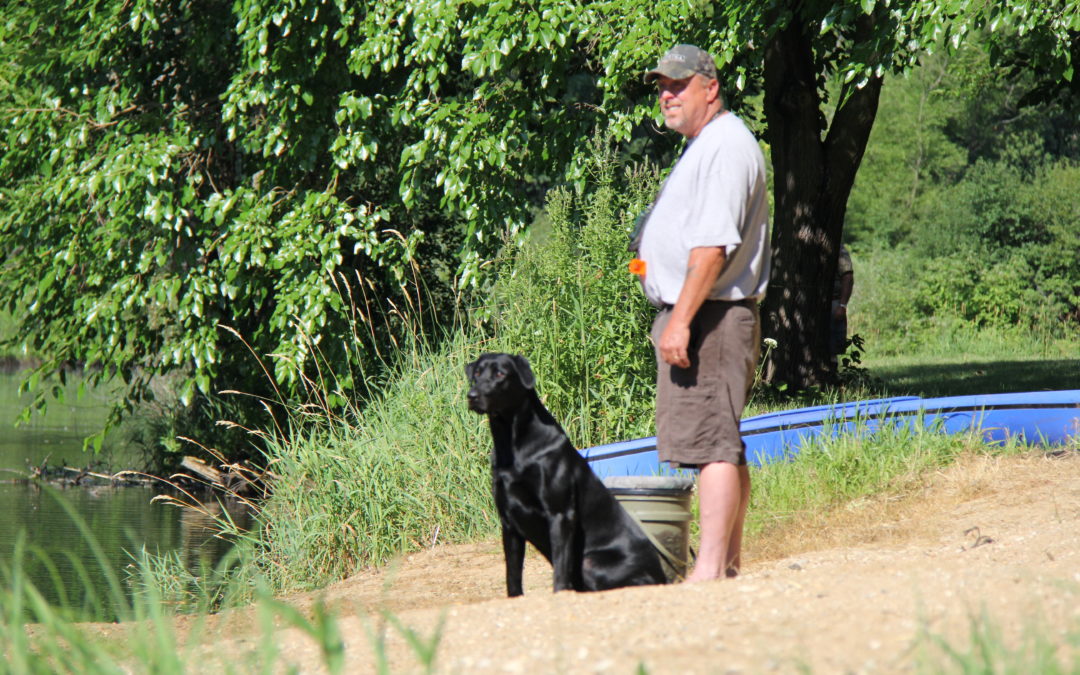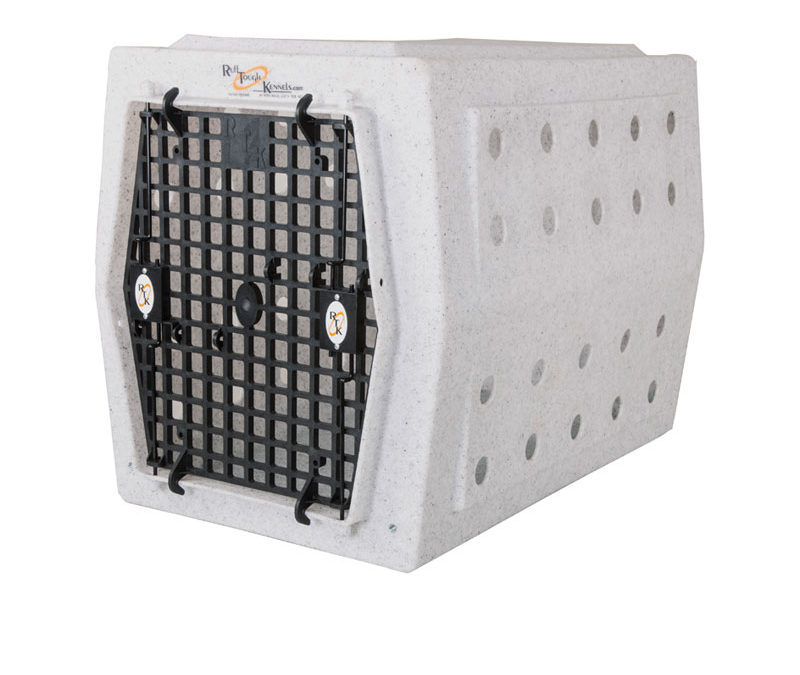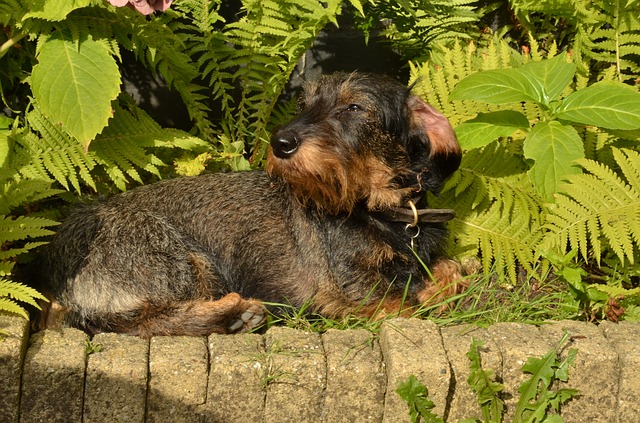
Getting and Keeping Your Dog Ready for Hunting Season?
Whether your dog is a veteran or a beginning bird dog, keeping your canine’s skills fresh throughout the year is important. Are you doing everything it takes to make sure your dog is ready to go and make the most of the limited time frame of hunting season? Listed here are skills you should work on during the summer to ensure dog is ready.
Functional Obedience
Regardless of your dog’s role in the household, he or she should practice obedience on a daily basis. For hunting dogs, field skills should be incorporated into these sessions. For instance, instead of simply asking your dog to “sit,” have him or her sit on an object, such as a tree stump. Instead of asking your dog to “heel” during a walk, put on waders and have your pet heel through a shallow pond. Obedience drills such as these will keep your dog’s hunting skills fresh.
Steadying / Honoring
Throughout your dog’s training, he or she learns that it is desirable to excitedly chase a bumper or dummy, which can decrease your dog’s steadiness and ability to honor your commands. Instead of throwing multiple retrieves everyday, throw numerous bumpers but only allow your dog to bring back 2 – 3 each session.
Lining
During the off season, dogs can become lazy and lose their good habits. One such habit is lining, which is running a straight, clean line towards the target. Work on this skill by throwing a bumper along a fence or building, which will force your dog to run as straight a line as possible. Increase the difficulty of this drill by adding obstacles for your dog to run over, such as a fallen log.
Marking
You will know your dog is almost ready for hunting season when he or she is marking well. To keep these skills fresh, choose more difficult marks that will challenge your dog. For instance, instead of tossing a bumper in an open field, throw the bumper from the field into thick cover which will simulate real-life scenarios.
Handling
Is your dog able to follow your hand signals and whistle reliably? Working on these skills in the off-season can pay huge dividends. A popular drill utilizes a real or imaginary baseball diamond. With your dog near the pitcher’s mound and you at home plate, use hand signals and your whistle to direct your dog to first, second, and third base. Eventually, use these cues to direct your dog towards hidden bumpers for retrieval, encouraging your pet to bring them directly to your hand.
Birds
If you use bumpers or dummies during the off-season, make sure to re-introduce real birds before the first hunt of the year. One simple way to incorporate game birds is to freeze carcasses throughout the year and bring them out for special training days. Bird wings can also be used.
Socialization
Make sure your dog is ready for everything that is encountered during a hunt. Like birds, you should reintroduce your dog to the sound of a gun before the first hunt of the season. Simulate a hunting scenario as closely as possible by firing multiple shots. Additionally, if you hunt in a boat make sure to incorporate training drills in the boat (in water or on dry land) before the first outing. Finally, make sure your dog remembers the purpose of the decoy by spending time running decoy drills. First, set up 6 – 8 decoys and then throw bumpers in front of, into, and past the group. Your dog should learn that birds are found in areas besides decoys for optimal skills.
Heat Acclimation
Be careful with your dog during the warmer months, and remember that your pet won’t have the same heat tolerance in June as he or she will in August. Start slowly, and keep your dog cool at all times. Train in the mornings or evenings and avoid direct sunlight. Utilize water training to get your dog into shape, such as by going on long retrieves. This will provide a better workout and will generally be safer than running your dog in warm weather.
Not sure what you should be doing or Need Help? Give Bull Valley Retrievers a call to help with your training regimen.

How and Why to Crate Train Your Dog
Dog crates are an important – and necessary – piece of dog training equipment. Here, the benefits of using a crate, as well as tips for utilizing this tool, will be discussed.
Why Use a Crate?
There are many reasons to use a crate. First and foremost, dogs are den animals that feel safest in small, confined areas. A crate provides a safe place for your pet to relax and retreat when life becomes chaotic. Additionally, crates are the safest place for your pet during travel, particularly during long car rides or trips on an airplane. In the house, crates provide an area to keep your pet safe while you are away, and to prevent destruction to furniture and upholstery. Finally, a crate is the easiest way to potty train a dog or puppy.
There are numerous times when a crate should not be used. These include as a form of punishment, or as long term “storage” in place of appropriate exercise and training.
Choosing a Crate
Crates can be manufactured from a variety of materials. The most common crates are made from wire, and this option provides the greatest amount of visibility and ventilation. Plastic, hard-sided crates are commonly used for travel and are more den-like than wire crates. Soft-sided crates are great for dogs that need a quiet place to sleep and are not prone to trying to chew their way out. For hunters or people who transport their dogs frequently, aluminum crates or Ruff Tough Kennels provide superior protection.
The size of your dog’s crate is an important consideration. Many first-time pet owners assume that the largest size crate as possible is best. However, when it comes to their den instincts, dogs prefer to relax in small, enclosed spaces. If your dog is ever put on bed-rest, a smaller crate will be necessary, as opposed to one that your pet can move around in. Finally, when it comes to potty training in a crate, small is best. Otherwise, your dog may learn to eliminate in one corner of the crate, and sleep on the clean side.
Therefore, the crate that you choose should be just large enough for your dog to comfortably stand up and turn around. If you are training a puppy that is expected to keep growing, look for a crate with a divider that allows you to expand the usable area as your pet grows.
Teaching Your Dog To Enjoy the Crate
The key to training your dog to use a crate is to associate the area with positivity. Make the crate as comfortable as possible by adding a soft crate mat or chew-proof bed. You can also include an interactive toy in the crate, such as a KONG or other indestructible item.
You should start slowly when crate training your dog, and not simply place your pet in the crate and walk away. The crate adjustment process can take a few days, but having patience is well worth it.
Begin by leaving the door to the crate open and providing praise when your dog is in the vicinity of the open door. Next, toss treats into the crate and provide profuse praise when your pet walks into the crate to retrieve them. You can also toss toys into the crate for your pet to fetch. Again, positive associations are key. As your dog becomes more comfortable with the kennel, begin feeding meals inside the crate. Gradually begin closing the door to the crate while your dog is inside, and leaving him or her there for increasing amounts of time. Once your dog has shown that he or she is comfortable with crated meal times, begin placing your pet in the crate for short durations throughout the day, again providing plenty of praise as you do so.
Some dogs will protest the crate at first. For these animals, it is important that you never let them out of the crate if they are whining or crying, as they will continue this behavior since it has been reinforced. Always wait for the dog to quiet down before opening the crate door.
When you leave your dog in the crate for extended periods of time, it can be helpful to provide a boredom busting toy or treat, such as a peanut butter filled KONG or a puzzle game. This type of reinforcement can also help your pet view the crate as something to look forward to being in, and not a reminder that you are gone.
Potty Training Your Dog with a Crate
Once your dog has been properly acclimated to the crate, you can use this tool for potty training. The crate works well for this purpose because dogs instinctively will not potty where they eat and sleep.
Whenever you are unable to keep an eye on your dog or puppy, he or she should be in the crate. It is important to note that your dog’s bladder capacity should be kept in mind, and it is unfair to expect your pet to be able to hold it for long periods of time. As a general rule of thumb, a puppy can hold his or her bladder and bowels for as many hours as it is months old. For instance, a 3 month old puppy needs to be let out at least every three hours.
The key to dog training is consistency. While you are in the house you should look for signs that your pet is going to eliminate and then immediately move your dog outside and praise him or her for pottying outdoors. However, if you will be unable to keep close watch on your dog while you are cooking or cleaning, for instance, your pet should be crated.
After an hour of being in the crate, take your puppy outside (preferably to the same area each time), give the “go potty” command, and wait until your dog eliminates. Afterwards, provide praise and a treat. If your dog does not potty, return him or her to crate without providing praise, and repeat the process in 20 – 30 minutes.
After your dog successfully potties outdoors, repeat the supervision or crating process. Consistently using the crate to keep your dog from having accidents indoors will speed up the potty training process and reduce the number of accidents in your home.

Keep Your Dog Away From These Common Plants
Did you know that one of the biggest hazards to your dog’s health might be lurking outside your back door – or even in your home? Here, common plants that are poisonous to dogs are discussed.
Sago Palm
The sago palm is most often found in the southern states, as it thrives in hot and humid climates. However, it can also be found indoors. The entire plant is poisonous to pets, with the toxins concentrated in the seeds. Symptoms of sago palm poisoning in dogs include vomiting, diarrhea, loss of appetite, seizures, collapse, jaundice, and black stools. Treatment includes induced vomiting by a veterinarian, as well as IV fluids and supportive care, depending on whether any internal organs were affected.
Lilies
Certain species of this springtime plant are highly dangerous to dogs, including the peace lily, calla lily, amaryllis, autumn crocus, giant Dracaena, palm lily, and lily of the valley. A dog that has ingested lilies or its bulbs will show signs of vomiting, loss of appetite, lethargy, and kidney disease. When caught in time, kidney damage can be prevented or reversed, but dogs will require a lengthy stay at the vet, as well as IV fluids and medication.
Cardiac Glycosides
Dogbane, milkweed, foxglove, and kalanchoe plants all contain a compound that is used in heart medication, such as Digitalis. Consumption of these plants results in vomiting, drooling, changes in heartbeat, electrolyte imbalance, tremors, and seizures. Dogs that have ingested cardiac glycosides must be taken to a veterinarian right away in order to stabilize heart rate and blood pressure.
Blue-green algae
If you have a pond or other water freshwater feature in your yard, you must beware the risks of cyanobacteria for your pets. Even a few licks of the bacteria can have severe consequences for your dog, such as liver failure and the development of neurological disorders. Symptoms include vomiting, diarrhea, black stool, dehydration, shock, seizures, jaundice, disorientation, paralysis, difficulty breathing, and death. A Dog that has consumed blue-green algae require immediate care, as toxicity can result in death in as little as 3 – 4 hours.
Araceae Houseplants
Houseplants from this family include philodendron, pothos, dumb cane, arrowhead vine, sweetheart vine, devil’s ivy, elephant ear, umbrella plant, and mother-in-law’s tongue. They are poisonous because of the insoluble calcium oxalate crystals they contain. When ingested, these crystals cause mouth pain, drooling, mouth swelling, and vomiting. However, these houseplants are not as poisonous as other plants on this list, and most symptoms can be treated at home with plain yogurt, which neutralizes the damage caused by the calcium oxalate crystals.
Soluble Calcium Oxalate-containing Plants
Plants that contain soluble calcium oxalate crystals such as english shamrock, rhubarb, and tropical star fruit can cause life threatening reactions by changing an animal’s blood chemistry. Signs of calcium poisoning include drooling, loss of appetite, vomiting, lethargy, abnormal urination, and tremors. Blood tests and IV fluids will be necessary for your pet.
Corn Plant and Dragon Tree
These plants contain saponin, which acts like a surfactant to hinder your dog’s ability to absorb nutrients from food. Symptoms include dilated pupils, vomiting, drooling, diarrhea, and lethargy, but corn plant and dragon tree are otherwise not extremely dangerous.
Spring Bulbs
Bulbs are attractive to dogs because they mimic many favorite toys. However, daffodils, tulips, and hyacinth can all cause vomiting, diarrhea, and intestinal obstruction. See your animal hospital Veterinarian if ingestion occurs. Treatment includes induced-vomiting, IV fluids, and supportive care.
Please note that this is not a complete list and if you dog shows any abnormal signs after ingesting anything, seek veterinary advice as soon as possible.
The ASPCA Animal Poison Control Center Phone Number is as follows: (888) 426-4435




Recent Comments